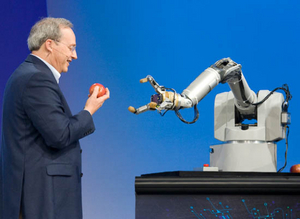
|
| ©Stephen Shankland/CNET News
|
| Intel Chief Technology Officer Justin Rattner agrees with futurist Ray Kurzweil's assessment that the "singularity", when machine intelligence surpasses human intelligence, is nigh.
|
Justin Rattner, CTO of Intel Cop. has predicted big changes in social interactions, robotics, and improvements in the computer's ability to sense the real world and he believes these changes will be seen sooner rather than later.
"The industry has taken much greater strides than anyone ever imagined 40 years ago," Rattner said, speaking at the Intel Developer's Forum. "There is speculation that we may be approaching an inflection point where the rate of technology advancements is accelerating at an exponential rate, and machines could even overtake humans in their ability to reason, in the not so distant future."
One such technology worthy of attention is Wireless Resonant Energy Link (WREL). It promises to deliver wireless power safely and efficiently, without using wires or plugs.
With this technology enabled in a laptop, for example, batteries could be recharged when the laptop gets within several feet of the transmit resonator. Many engineering challenges remain, but the company's researchers hope to find a way to cut the last cord in mobile devices and someday enable wireless power in Intel-based platforms.
Rattner also said that Intel researchers are working on how to use millions of tiny micro-robot, called catoms, to build shape-shifting materials.
According to Ratter, if used to replace the case, display, and keyboard of a computing device, this technology could make it possible for a device to change physical form in order to suit the specific way that it is being used.
A mobile computer, for example, could be tiny when in a pocket, change to the shape of an earpiece when used as a mobile phone, and be large and flat with a keyboard for browsing the Internet or watching a movie.
Rattner described this as a difficult exploratory research agenda, but steady progress is being made. He demonstrated for the first time the results of a novel technique for fabricating tiny silicon hemispheres using photolithography, a process used today to make silicon chips.
This capability is one of the basic structural building blocks needed to realize functional catoms, and will make it easier to bring the necessary computational and mechanical components together in one tiny package less than a millimeter across. The technique is compatible with existing high-volume manufacturing and enables the possibility to produce such catoms in quantity at some point in the future.
Intel is also researching how to go beyond planar transistors to 3D transistors and is looking at using compound semiconductors to replace silicon in the transistor channel. Looking further out, Intel is exploring into a variety of non-charge-based technologies that could one day replace CMOS altogether.
Robotics is another area that Rattner feels will grow in the years to come,with more innovation will emerge to make human and machine interaction more robust. To make robotics personal, robots need to move and manipulate objects in cluttered and dynamic human environments, according to Rattner.
He demonstrated two working personal robot prototypes developed at Intel's research labs. One of the demonstrations showed electric field pre-touch that has been built into a robot hand. The technique is a novel sensing modality used by fish but not humans, so they can "feel" objects before they even touch them.
The other demonstration was a complete autonomous mobile manipulation robot that can recognize faces and interpret and execute commands as generic as "please clean this mess" using state-of-the-art motion planning, manipulation, perception and artificial intelligence.
Reader Comments
to our Newsletter